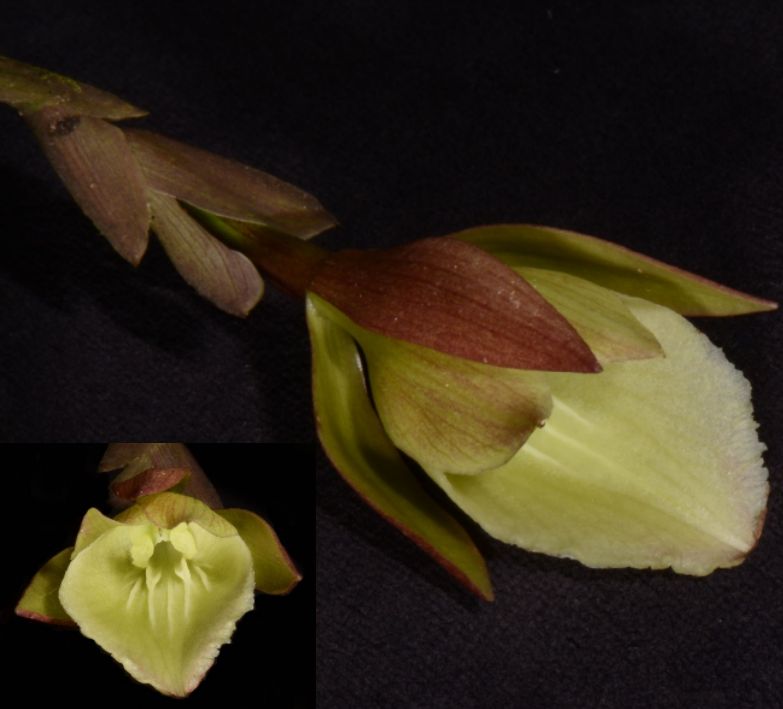

Epidendrum phtiarichilum Hágsater, E.Santiago & Tobar 2018 GROUP Alberti SUBGROUP Allenii
TYPE Photo by Eric Hagsater/Drawing © by R Jimenez and The AMO Herbario Website





Common Name The Shovel Shaped Lip Epidendrum
Flower Size 1.2" [3 cm]
Found in Ecuador on the western slopes of the Cordillera del Cóndor in wet tropical forest, at elevations of 1561 to 1600 meters as a medium sized, cool growing epiphyte with simple, canelike, terete at the base, laterally compressed towards the apex, erect, straight stems covered near the base by non-foliar, scarious, becoming fibrious with time sheaths and carrying up to 11, distributed throughout the stem, alternate, articulate, sub-spreading; tubular, ancipitose, striated basal sheaths; blade elliptic, acuminate, margin entire, spreading leaves that blooms in the fall, winter and spring on a terminal and or lateral, the lateral produced near the base of the mature stems, sometimes appearing to be basal inflorescences, arising through a single, at the apex of the peduncle of the apical inflorescence, conduplicate, oblong, apiculate spathe, peduncle 1.6 to 2" [4 to 5 cm] long, terete and thin at the base, laterally compressed and gradually wider towatds the apex, slightly ancipitose, green, concolor, rachis totally hidden by the spathe and floral bracts, 2.2 to 3.6" [5.5 to 9.0 cm] long overall, generally producing short, successively single, 3 to 4 flowerd racemes in successive years from the same inflorescence with half as long as the ovary, ovate elliptic (when spread), narrowly elliptic, oblique and condulicate in natural position, acute, imbricating at the base, persistent in old inflorescence greenish brown floral bracts and carrying resupinate, without fragrance, pale green flowers with the sepals dorsally tinged copper color, petals dorsally slightly tinged brownish, especially along the veins, lip concolor and immaculate.
"Epidendrum phtiarichilum belongs to the GROUP Albertii, characterized by the sympodial habit, stems laterally compressed to ancipitose, or somewhat thickened and fusiform, inflorescence apical and/or lateral, racemose, distichous, the bracts more or less imbricating, conduplicate, producing one flower at a time, and the SUBGROUP Albertii, which has apical and more frequently lateral inflorescences. The new species is recognized by the tall plants, to 23.2" [58 cm], but especially by the very large flowers, sepals lanceolate, .14 to .16" [35 to 40 mm] long, with a shovel-shaped, obovate-elliptic lip, 1.6 x 1.04" [40 x 26 mm], and petals lanceolate-elliptic, acute, .16 to .16 x .44 to .48" [35 to 40 x 11 to 12 cm]. Epidendrum dalessandroi has taller plants to 52" [130 cm] tall, ancipitose cane-like stems; long, ancipitose peduncle of the inflorescence covered partially by rounded conduplicate bracts, and smaller flowers, sepals .8 to .88" [20 to 22 mm] long, petals oblong, .8 x 1.08 to 1.2" [20 x 2.6 to 3.0 mm], and the lip .68 x .88" [17 x 22 mm], convex, cordiform, emarginate, the column prolonged by the long, entire clinandrium. Epidendrum phyllocharis Rchb.f. has somewhat flattened stems, bilobed leaves, and smaller flowers, the dorsal sepal spreading, erect, lip 5-angled. Epidendrum chuspipatense Hágsater & R.Vásquez from Bolivia also has tall plants, but flowers are smaller, sepals .84 to .88" [21 to 22 mm] long, and the lip is cordate to suborbicular, the margins spreading and the sides somewhat recurved in natural position so as to be saddle-shaped in natural position, instead of shovel-shaped." Hagsater 2018
Synonyms
References W3 Tropicos, Kew Monocot list , IPNI ; *Icones Orchidacearum 16[1} Plate 1649 Hagsater & Sanchez 2018 drawing/photo fide;
----------------------------------------------------------------------------------------------------------